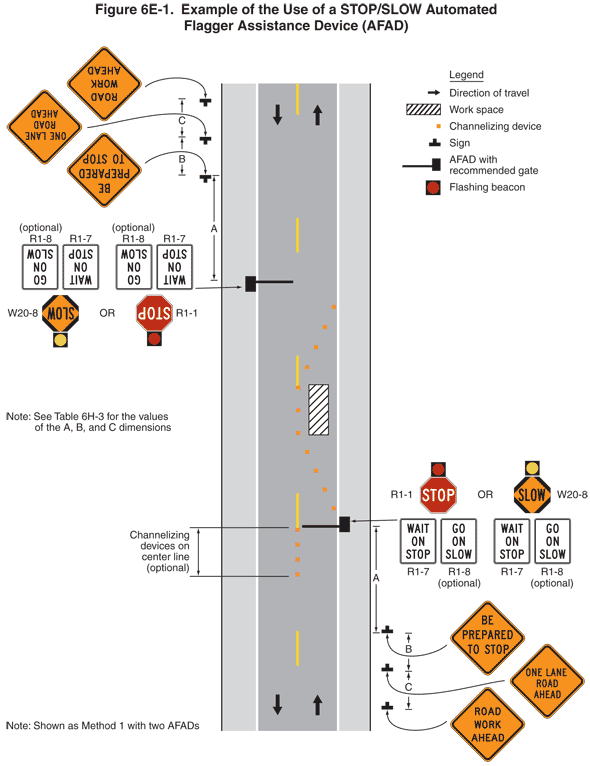2009 Edition Part 6 Figure 6E-1. Example of the Use of a STOP/SLOW Automated Flagger Assistance Device (AFAD)

Figure 6E-1. Example of the Use of a STOP/SLOW Automated Flagger Assistance Device (AFAD)
This figure illustrates an example of using a STOP/SLOW Automated Flagger Assistance Device (AFAD).
A legend shows a black arrow indicating the direction of travel on the roadway lanes, a diagonally striped rectangle denoting a work space, a yellow square denoting a channelizing device, a short inverted "T" denoting a sign, a black square attached to a horizontal black line denoting an AFAD with a recommended gate, and a white square containing a colored circle denoting a flashing beacon.
A note states "See Table 6H-3 for the values of the A, B, and C dimensions."
This figure shows a vertical two-lane roadway with one lane of traffic in each direction. Downward-pointing black arrows in the left lane and upward-pointing arrows in the right lane denote the direction of traffic. The opposing lanes are shown separated by a broken yellow line. A shoulder is shown to the right of each travel lane. The shoulders are shown separated from the travel lanes by a solid white line.
At the bottom of the figure and to the right of the northbound shoulder, a black inverted "T" is shown denoting a sign. The sign is shown as a diamond-shaped orange sign with a black border and the words "ROAD WORK AHEAD" in black. Beyond the sign, at a dimensioned distance C, a sign is shown to the right of the shoulder. It is shown as a diamond-shaped orange sign with a black border and the words "ONE LANE ROAD AHEAD" in black. This sign assembly is shown at a dimensioned distance B in advance of a diamond-shaped orange sign with a black border shown to the right of the shoulder. The sign shows a diamond-shaped orange sign with a black border and the words "BE PREPARED TO STOP" in black. Beyond this sign, at a dimensioned distance A, a sign assembly is shown on a symbol for AFAD with recommended gate. In advance of the AFAD symbol, a series of four orange squares denoting channelizing devices are shown on the center line and marked optional. The sign assembly is shown composed of an R1-1 STOP sign with a flashing red beacon mounted above it. These are shown mounted above two signs aligned horizontally. They are shown as an R1-7 sign shown as a vertical rectangular white sign with a black border and the words "WAIT ON STOP" in black on three lines to the left of an R1-8 sign shown as a vertical rectangular white sign with a black border and the words "GO ON SLOW" in black on three lines and marked optional. To the right of this sign assembly, the word "OR" is shown and another sign assembly. It is shown as identical to the first sign assembly except a W20-8 "SLOW" sign with a flashing yellow beacon is shown instead of the STOP sign and flashing red beacon.
Adjacent to this sign assembly, a series of orange squares, denoting channelizing devices, is shown. The devices are shown beginning at the far right edge of the right lane and tapering to the left to the broken yellow line separating the opposing travel lanes. Further toward the top of the figure, a vertical rectangle with diagonal black and white stripes, denoting a work space, is shown in the right lane. To the left of the work space, a row of channelizing devices is shown along the broken yellow line. The channelizing devices then are shown tapering from the broken yellow line back to the right edge of the right lane.
At the top of the figure and to the right of the shoulder of the southbound lane, the same series of diamond-shaped orange signs, AFAD symbol, and sign assembly are shown that are shown for the northbound lane.
A note states "Shown as Method 1 with two AFADs."
